

Compact Muon Solenoid
LHC, CERN
| CMS-HIN-17-006 ; CERN-EP-2018-294 | ||
| Pseudorapidity distributions of charged hadrons in xenon-xenon collisions at ${\sqrt {\smash [b]{s_{_{\mathrm {NN}}}}}} = $ 5.44 TeV | ||
| CMS Collaboration | ||
| 10 February 2019 | ||
| Phys. Lett. B 799 (2019) 135049 | ||
| Abstract: Measurements of the pseudorapidity distributions of charged hadrons produced in xenon-xenon collisions at a nucleon-nucleon centre-of-mass energy of ${\sqrt {\smash [b]{s_{_{\mathrm {NN}}}}}} = $ 5.44 TeV are presented. The measurements are based on data collected by the CMS experiment at the LHC. The yield of primary charged hadrons produced in xenon-xenon collisions in the pseudorapidity range $| \eta | < $ 3.2 is determined using the silicon pixel detector in the CMS tracking system. For the 5% most central collisions, the charged-hadron pseudorapidity density in the midrapidity region $| \eta | < $ 0.5 is found to be 1187 $\pm$ 36 (syst), with a negligible statistical uncertainty. The rapidity distribution of charged hadrons is also presented in the range $| y | < $ 3.2 and is found to be independent of rapidity around $y =$ 0. Comparisons of charged-hadron multiplicities between xenon-xenon and lead-lead collisions at similar collision energies show that particle production at midrapidity is strongly dependent on the collision geometry in addition to the system size and collision energy. | ||
| Links: e-print arXiv:1902.03603 [hep-ex] (PDF) ; CDS record ; inSPIRE record ; HepData record ; CADI line (restricted) ; | ||
| Figures | |

png pdf |
Figure 1:
The ${\Delta r}$ distributions for tracklets reconstructed from the two layers of the BPIX closest to the beam pipe. The distributions are normalised by the number of tracklets. The spectrum in collision data (black squares) is compared to the spectra obtained from fully simulated events generated with Epos LHC v3400 [16,17], Hydjet 1.9 [18], and Ampt 1.26t5 [19]. The ratio of the distributions in simulation to data is shown in the bottom panel. The statistical uncertainties are smaller than the marker sizes for all distributions shown. |
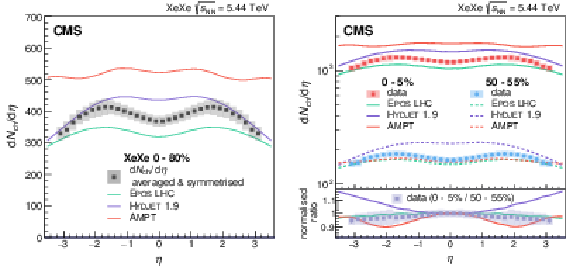
png pdf |
Figure 2:
Averaged and symmetrised ${{\mathrm {d}}N_{\mathrm {ch}}/ {\mathrm {d}}\eta}$ distributions (grey squares) in XeXe collisions at $ {\sqrt {\smash [b]{s_{_{\mathrm {NN}}}}}} = $ 5.44 TeV, for events in (left) the 0-80% centrality interval, as well as (right) the 0-5% (red squares) and 50-55% (blue circles) centrality intervals. Predictions from the Epos LHC v3400 [16,17], Hydjet 1.9 [18], and Ampt 1.26t5 [19] event generators are also shown for comparison. The ratios of the ${{\mathrm {d}}N_{\mathrm {ch}}/ {\mathrm {d}}\eta}$ distributions for events in the 0-5% to those in the 50-55% centrality interval, normalised to unity at midrapidity, are shown in the bottom panel. The bands around the data points denote the total systematic uncertainties, while the statistical uncertainties are negligible. |

png pdf |
Figure 2-a:
Averaged and symmetrised ${{\mathrm {d}}N_{\mathrm {ch}}/ {\mathrm {d}}\eta}$ distributions (grey squares) in XeXe collisions at $ {\sqrt {\smash [b]{s_{_{\mathrm {NN}}}}}} = $ 5.44 TeV, for events in the 0-80% centrality interval centrality interval. Predictions from the Epos LHC v3400 [16,17], Hydjet 1.9 [18], and Ampt 1.26t5 [19] event generators are also shown for comparison. The ratios of the ${{\mathrm {d}}N_{\mathrm {ch}}/ {\mathrm {d}}\eta}$ distributions for events in the 0-5% to those in the 50-55% centrality interval, normalised to unity at midrapidity, are shown in the bottom panel. The bands around the data points denote the total systematic uncertainties, while the statistical uncertainties are negligible. |

png pdf |
Figure 2-b:
Averaged and symmetrised ${{\mathrm {d}}N_{\mathrm {ch}}/ {\mathrm {d}}\eta}$ distributions (grey squares) in XeXe collisions at $ {\sqrt {\smash [b]{s_{_{\mathrm {NN}}}}}} = $ 5.44 TeV, for events in the 0-5% (red squares) and 50-55% (blue circles) centrality intervals. Predictions from the Epos LHC v3400 [16,17], Hydjet 1.9 [18], and Ampt 1.26t5 [19] event generators are also shown for comparison. The ratios of the ${{\mathrm {d}}N_{\mathrm {ch}}/ {\mathrm {d}}\eta}$ distributions for events in the 0-5% to those in the 50-55% centrality interval, normalised to unity at midrapidity, are shown in the bottom panel. The bands around the data points denote the total systematic uncertainties, while the statistical uncertainties are negligible. |

png pdf |
Figure 3:
Averaged and symmetrised charged-hadron $ {{\mathrm {d}}N_{\mathrm {ch}}/ {\mathrm {d}}y} $ distribution in XeXe collisions at $ {\sqrt {\smash [b]{s_{_{\mathrm {NN}}}}}} = $ 5.44 TeV for events with 0-80% centrality (grey squares). The band around the data points denotes the total systematic uncertainties, while the statistical uncertainties are negligible. Predictions from the Epos LHC v3400 [16,17], Hydjet 1.9 [18], and Ampt 1.26t5 [19] event generators are also shown in comparison. |
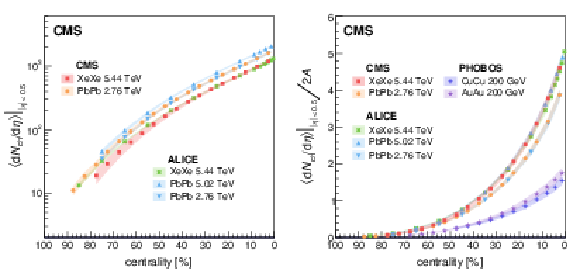
png pdf |
Figure 4:
Charged-hadron ${{\mathrm {d}}N_{\mathrm {ch}}/ {\mathrm {d}}\eta}$ in XeXe collisions at $ {\sqrt {\smash [b]{s_{_{\mathrm {NN}}}}}} = $ 5.44 TeV at midrapidity as a function of event centrality, shown as is (left) and normalised by 2$A$ (right), where $A$ is the atomic number of the nuclei. The results are compared to measurements in PbPb and XeXe collisions by the CMS [14] and ALICE [34,35,15] Collaborations, and to measurements in CuCu and AuAu collisions by the PHOBOS Collaboration [36]. The bands around the data points denote the total systematic uncertainties, while the statistical uncertainties are negligible. |

png pdf |
Figure 4-a:
Charged-hadron ${{\mathrm {d}}N_{\mathrm {ch}}/ {\mathrm {d}}\eta}$ in XeXe collisions at $ {\sqrt {\smash [b]{s_{_{\mathrm {NN}}}}}} = $ 5.44 TeV at midrapidity as a function of event centrality, shown as is. The results are compared to measurements in PbPb and XeXe collisions by the CMS [14] and ALICE [34,35,15] Collaborations, and to measurements in CuCu and AuAu collisions by the PHOBOS Collaboration [36]. The bands around the data points denote the total systematic uncertainties, while the statistical uncertainties are negligible. |
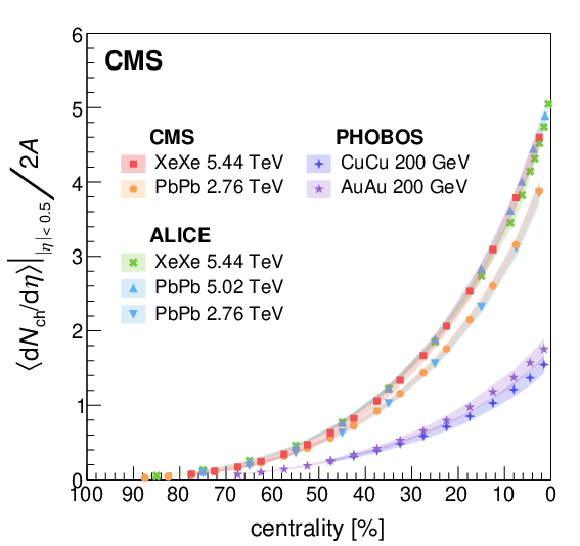
png pdf |
Figure 4-b:
Charged-hadron ${{\mathrm {d}}N_{\mathrm {ch}}/ {\mathrm {d}}\eta}$ in XeXe collisions at $ {\sqrt {\smash [b]{s_{_{\mathrm {NN}}}}}} = $ 5.44 TeV at midrapidity as a function of event centrality, shown normalised by 2$A$, where $A$ is the atomic number of the nuclei. The results are compared to measurements in PbPb and XeXe collisions by the CMS [14] and ALICE [34,35,15] Collaborations, and to measurements in CuCu and AuAu collisions by the PHOBOS Collaboration [36]. The bands around the data points denote the total systematic uncertainties, while the statistical uncertainties are negligible. |
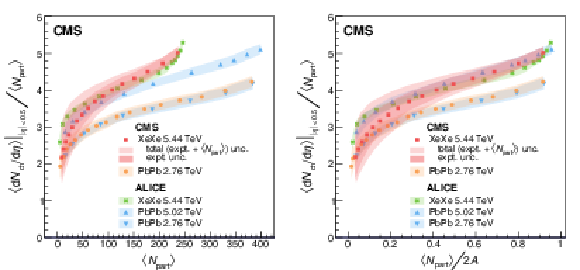
png pdf |
Figure 5:
Average ${{\mathrm {d}}N_{\mathrm {ch}}/ {\mathrm {d}}\eta}$ at midrapidity normalised by $ {< N_{\mathrm {part}} >} $, shown as a function of $ {< N_{\mathrm {part}} >} $ (left) and $ {< N_{\mathrm {part}} >} /2A$ (right), where $A$ is the atomic number of the nuclei. The results are compared to measurements in PbPb and XeXe collisions by the CMS [14] and ALICE [34,35,15] Collaborations. The bands around the data points denote the systematic uncertainties, while the statistical uncertainties are negligible. |

png pdf |
Figure 5-a:
Average ${{\mathrm {d}}N_{\mathrm {ch}}/ {\mathrm {d}}\eta}$ at midrapidity normalised by $ {< N_{\mathrm {part}} >} $, shown as a function of $ {< N_{\mathrm {part}} >} $. The results are compared to measurements in PbPb and XeXe collisions by the CMS [14] and ALICE [34,35,15] Collaborations. The bands around the data points denote the systematic uncertainties, while the statistical uncertainties are negligible. |
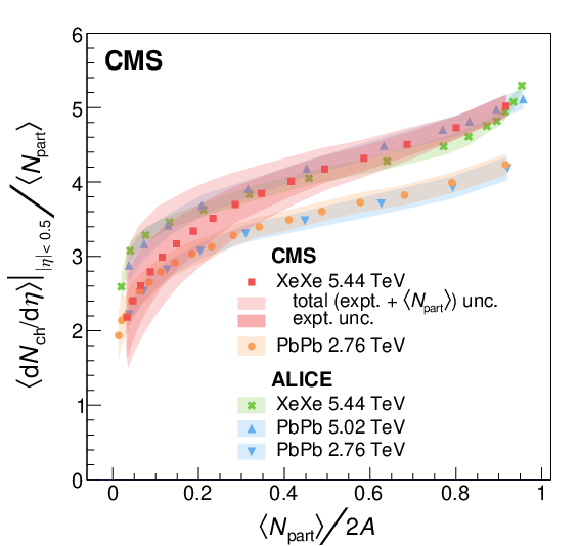
png pdf |
Figure 5-b:
Average ${{\mathrm {d}}N_{\mathrm {ch}}/ {\mathrm {d}}\eta}$ at midrapidity normalised by $ {< N_{\mathrm {part}} >} $, shown as a function of $ {< N_{\mathrm {part}} >} /2A$, where $A$ is the atomic number of the nuclei. The results are compared to measurements in PbPb and XeXe collisions by the CMS [14] and ALICE [34,35,15] Collaborations. The bands around the data points denote the systematic uncertainties, while the statistical uncertainties are negligible. |
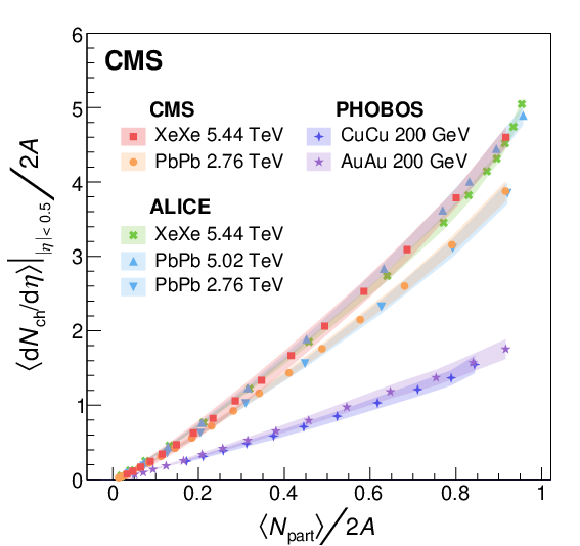
png pdf |
Figure 6:
Average ${{\mathrm {d}}N_{\mathrm {ch}}/ {\mathrm {d}}\eta}$ at midrapidity normalised by 2$A$, shown as a function of $ {< N_{\mathrm {part}} >} /2A$, where $A$ is the atomic number of the nuclei. The results are compared to measurements in PbPb and XeXe collisions by the CMS [14] and ALICE [34,35,15] Collaborations, and to measurements in CuCu and AuAu collisions by the PHOBOS Collaboration [36]. The bands around the data points denote the systematic uncertainties, while the statistical uncertainties are negligible. |
| Tables | |

png pdf |
Table 1:
Summary of systematic uncertainties |
| Summary |
| The pseudorapidity distributions of charged hadrons in xenon-xenon collisions at a centre-of-mass energy of 5.44 TeV per nucleon pair are reported. Using data taken with the upgraded 4-layer silicon pixel detectors, the charged-hadron pseudorapidity densities, $ \mathrm{d} N_{\mathrm{ch}} /\mathrm{d} \eta $, are measured to an extended $\eta$ range of $| \eta | < $ 3.2. For events in the 0-5% centrality interval, the $ \mathrm{d} N_{\mathrm{ch}} /\mathrm{d} \eta $ at midrapidity is measured to be 1187 $\pm$ 36 (syst), with a negligible statistical uncertainty. The results are found to be consistent with the ALICE Collaboration's measurement. The charged-hadron rapidity density is also presented, and is found to be consistent with a flat rapidity plateau in the region $| y | < $ 1. The results are compared to predictions from the EPOS LHC v3400, HYDJET 1.9, and AMPT 1.26t5 event generators. None of the event generators are able to fully describe the measurements in terms of the magnitude, pseudorapidity dependence, and centrality dependence of the $ \mathrm{d} N_{\mathrm{ch}} /\mathrm{d} \eta $ distributions, although EPOS LHC describes well the pseudorapidity dependence and its centrality dependence. The per-participant $ \mathrm{d} N_{\mathrm{ch}} /\mathrm{d} \eta $ at midrapidity in XeXe collisions is observed to rise faster with $ N_{\mathrm{part}} $ than in PbPb collisions. However, when comparing events with similar fractional overlap, the per-participant $ \mathrm{d} N_{\mathrm{ch}} /\mathrm{d} \eta $ is consistent between the two collision systems. The results also show that the $ \mathrm{d} N_{\mathrm{ch}} /\mathrm{d} \eta $ at midrapidity is a function of the collision geometry after normalising by 2$A$, where $A$, is the atomic number of the nuclei. This is observed for a variety of collision systems and energies, both at RHIC and the LHC, demonstrating that final-state charged-hadron multiplicities are strongly dependent on the collision geometry. These results provide important constraints on models and generators which describe multiparticle production in heavy ion collisions at high energies. They may also help in the characterisation of the initial conditions of the quark gluon plasma, which is needed for the understanding of its subsequent hydrodynamic evolution, as well as the properties of this fluid. |
| References | ||||
| 1 | W. Busza, K. Rajagopal, and W. van der Schee | Heavy ion collisions: The big picture, and the big questions | Annual Review of Nuclear and Particle Science 68 (2018) 339 | 1802.04801 |
| 2 | P. Romatschke and U. Romatschke | Relativistic fluid dynamics in and out of equilibrium -- ten years of progress in theory and numerical simulations of nuclear collisions | 1712.05815 | |
| 3 | J. L. Albacete and C. Marquet | Gluon saturation and initial conditions for relativistic heavy ion collisions | Prog. Part. NP 76 (2014) 1 | 1401.4866 |
| 4 | D. Kharzeev and M. Nardi | Hadron production in nuclear collisions at RHIC and high density QCD | PLB 507 (2001) 121 | nucl-th/0012025 |
| 5 | D. d'Enterria et al. | Constraints from the first LHC data on hadronic event generators for ultra-high energy cosmic-ray physics | Astropart. Phys. 35 (2011) 98 | 1101.5596 |
| 6 | PHOBOS Collaboration | System size, energy and centrality dependence of pseudorapidity distributions of charged particles in relativistic heavy ion collisions | PRL 102 (2009) 142301 | 0709.4008 |
| 7 | W.-T. Deng, X.-N. Wang, and R. Xu | Gluon shadowing and hadron production in heavy-ion collisions at LHC | PLB 701 (2011) 133 | 1011.5907 |
| 8 | CMS Collaboration | Transverse momentum and pseudorapidity distributions of charged hadrons in pp collisions at $ \sqrt{s} = $ 0.9 and 2.36 TeV | JHEP 02 (2010) 041 | CMS-QCD-09-010 1002.0621 |
| 9 | CMS Collaboration | Transverse-momentum and pseudorapidity distributions of charged hadrons in pp collisions at $ \sqrt{s} = $ 7 TeV | PRL 105 (2010) 022002 | CMS-QCD-10-006 1005.3299 |
| 10 | CMS Collaboration | Charged particle multiplicities in pp interactions at $ \sqrt{s} = $ 0.9 , 2.36, and 7 TeV | JHEP 01 (2011) 079 | CMS-QCD-10-004 1011.5531 |
| 11 | CMS, TOTEM Collaboration | Measurement of pseudorapidity distributions of charged particles in proton-proton collisions at $ \sqrt{s} = $ 8 TeV by the CMS and TOTEM experiments | EPJC 74 (2014) 3053 | 1405.0722 |
| 12 | CMS Collaboration | Pseudorapidity distribution of charged hadrons in proton-proton collisions at $ \sqrt{s} = $ 13 TeV | PLB 751 (2015) 143 | CMS-FSQ-15-001 1507.05915 |
| 13 | CMS Collaboration | Pseudorapidity distributions of charged hadrons in proton-lead collisions at $ {\sqrt {\smash [b]{s_{_{\mathrm {NN}}}}}} = $ 5.02 and 8.16 TeV | JHEP 01 (2018) 045 | CMS-HIN-16-021 1710.09355 |
| 14 | CMS Collaboration | Dependence on pseudorapidity and centrality of charged hadron production in PbPb collisions at a nucleon-nucleon centre-of-mass energy of 2.76 TeV | JHEP 08 (2011) 141 | CMS-HIN-10-001 1107.4800 |
| 15 | ALICE Collaboration | Centrality and pseudorapidity dependence of the charged-particle multiplicity density in Xe-Xe collisions at $ {\sqrt {\smash [b]{s_{_{\mathrm {NN}}}}}} = $ 5.44 TeV | Submitted to PLB | 1805.04432 |
| 16 | K. Werner, F.-M. Liu, and T. Pierog | Parton ladder splitting and the rapidity dependence of transverse momentum spectra in deuteron-gold collisions at RHIC | PRC 74 (2006) 044902 | hep-ph/0506232 |
| 17 | T. Pierog et al. | EPOS LHC: Test of collective hadronization with data measured at the CERN Large Hadron Collider | PRC 92 (2015) 034906 | 1306.0121 |
| 18 | I. P. Lokhtin and A. M. Snigirev | A model of jet quenching in ultrarelativistic heavy ion collisions and high-$ {p_{\mathrm{T}}} $ hadron spectra at RHIC | EPJC 45 (2006) 211 | hep-ph/0506189 |
| 19 | Z.-W. Lin et al. | A multi-phase transport model for relativistic heavy ion collisions | PRC 72 (2005) 064901 | nucl-th/0411110 |
| 20 | V. N. Gribov | A Reggeon diagram technique | Sov. Phys. JETP 26 (1968) 414.[\itZh. Eksp. Teor. Fiz. \bf53 (1967) 654] | |
| 21 | H. J. Drescher et al. | Parton based Gribov-Regge theory | PR 350 (2001) 93 | hep-ph/0007198 |
| 22 | X.-N. Wang and M. Gyulassy | HIJING: A Monte Carlo model for multiple jet production in pp, pA and AA collisions | PRD 44 (1991) 3501 | |
| 23 | B. Zhang | ZPC 1.0.1: A parton cascade for ultrarelativistic heavy ion collisions | CPC 109 (1998) 193 | nucl-th/9709009 |
| 24 | B.-A. Li and C. M. Ko | Formation of superdense hadronic matter in high-energy heavy ion collisions | PRC 52 (1995) 2037 | nucl-th/9505016 |
| 25 | CMS Collaboration | The CMS experiment at the CERN LHC | JINST 3 (2008) S08004 | CMS-00-001 |
| 26 | CMS Collaboration | CMS technical design report for the pixel detector upgrade | ||
| 27 | S. R. Klein et al. | STARlight: A Monte Carlo simulation program for ultra-peripheral collisions of relativistic ions | CPC 212 (2017) 258 | 1607.03838 |
| 28 | S. Roesler, R. Engel, and J. Ranft | The Monte Carlo event generator DPMJET-III | Advanced Monte Carlo for radiation physics, particle transport simulation and applications. Proceedings, Conference, MC2000, Lisbon (2000) | hep-ph/0012252 |
| 29 | CMS Collaboration | Observation and studies of jet quenching in PbPb collisions at nucleon-nucleon center-of-mass energy = 2.76 TeV | PRC 84 (2011) 024906 | CMS-HIN-10-004 1102.1957 |
| 30 | GEANT4 Collaboration | GEANT4--a simulation toolkit | NIMA 506 (2003) 250 | |
| 31 | ALICE Collaboration | Centrality dependence of the pseudorapidity density distribution for charged particles in Pb-Pb collisions at $ {\sqrt {\smash [b]{s_{_{\mathrm {NN}}}}}} = $ 2.76 TeV | PLB 726 (2013) 610 | 1304.0347 |
| 32 | ALICE Collaboration | Centrality dependence of the pseudorapidity density distribution for charged particles in Pb-Pb collisions at $ {\sqrt {\smash [b]{s_{_{\mathrm {NN}}}}}} = $ 5.02 TeV | PLB 772 (2017) 567 | 1612.08966 |
| 33 | C. Loizides and A. Morsch | Absence of jet quenching in peripheral nucleus-nucleus collisions | PLB 773 (2017) 408 | 1705.08856 |
| 34 | ALICE Collaboration | Centrality dependence of the charged-particle multiplicity density at mid-rapidity in Pb-Pb collisions at $ {\sqrt {\smash [b]{s_{_{\mathrm {NN}}}}}} = $ 2.76 TeV | PRL 106 (2011) 032301 | 1012.1657 |
| 35 | ALICE Collaboration | Centrality dependence of the charged-particle multiplicity density at midrapidity in Pb-Pb collisions at $ {\sqrt {\smash [b]{s_{_{\mathrm {NN}}}}}} = $ 5.02 TeV | PRL 116 (2016) 222302 | 1512.06104 |
| 36 | PHOBOS Collaboration | Phobos results on charged particle multiplicity and pseudorapidity distributions in Au+Au, Cu+Cu, d+Au, and p+p collisions at ultra-relativistic energies | PRC 83 (2011) 024913 | 1011.1940 |
| 37 | M. L. Miller, K. Reygers, S. J. Sanders, and P. Steinberg | Glauber modeling in high energy nuclear collisions | Ann. Rev. Nucl. Part. Sci. 57 (2007) 205 | nucl-ex/0701025 |
| 38 | C. Loizides, J. Kamin, and D. d'Enterria | Improved Monte Carlo Glauber predictions at present and future nuclear colliders | PRC 97 (2018) 054910 | 1710.07098 |

|
Compact Muon Solenoid LHC, CERN |

|

|

|

|

|

|